2023.08.01.79
Files > Volume 8 > Vol 8 No 1 2023
Effect of adding beetroot (Beta vulgaris rubra) powder and its aqueous extract to growing geese carcasses on carcass quality and measures
Saad K.J. Al-waeli1 , Majid H.A. Alasadi2 and Rabia J. Abbas2*
1Animal Production Department, College of Agriculture, Al-Muthanna University, Iraq.
2 Animal Production Department, College of Agriculture, University of Basrah, Iraq.
*Corresponding author. Email: [email protected]
Available from: http://dx.doi.org/10.21931/RB/2023.08.01.79
ABSTRACT
The present study investigated the influence of supplementing beetroot (Beta vulgaris rubra) powder and its aqueous extract on growing goose's carcass quality and carcass measurements. One hundred eighty one-day-old goslings chicks of Chinese white geese were randomly distributed among five treatment groups containing three replicates of 12 birds each. Five experimental diets were formulated as follows: Control diet without supplementation (T1). T2 and T3, the beetroot extract was supplemented at 15 and 30 (ml/ L) in drinking water; 15, and 30 (g/kg) beetroot powder (T4, T5) in basal diet, respectively. Results indicate that the use of beetroot significantly improved all traits of the studied goose carcass compared to the control treatment, the addition of the aqueous extract at a concentration of 15 ml/ liter of drinking water and beetroot powder at a concentration of 15 g to the feed gave the best results and significantly compared to the rest of the treatments.
Keywords: beetroot (Beta vulgaris rubra), carcass quality, carcass measurements, growing goose
INTRODUCTION
Beetroot is a rich source of phytochemical compounds, including ascorbic acid, carotenoids, phenolic acids, and flavonoids, as well as containing a group of highly biologically active pigments known as Betacaine, which are classified as either betacyanin pigments with a red-violet color or Betaxanthin yellow-orange pigments1. Betalains are antioxidant and anti-inflammatory, in addition to their role in combating clinical diseases characterized by oxidative stress and chronic inflammation, such as liver disease2, arthritis3,4, and cancer5.
The plant extract of beetroot, ginger root and tomato at a concentration of 0.5 and 1.0%, it did not differ significantly in the dressing percentage, the relative weight of the liver (Liver), the gizzard, the heart (Heart) and abdominal fat, compared with the control treatment of broiler carcasses of Arbor Acres hybrid broilers6,7.
Moreover,.8 explains that drinking water is served with beetroot juice at levels of 10, 20 and 30 ml/liter of drinking water, it significantly improved the percentage of dressing with edible viscera of Marshal crossbred broiler carcasses, the level of 20 and 30 ml/liter of drinking water improved the relative weight of the heart compared to the control treatment, the level of 30 ml/liter of drinking water gave the best rates, significantly, compared to the level of 10 ml/liter of drinking water and the control treatment in the relative weight of the liver, no significant differences were observed among all treatments in the relative weight of gizzard, thigh and breast.
The current study aims to show the effect of supplementing beetroot (Beta vulgaris rubra) powder and its aqueous extract on carcass quality and carcass measurements of growing goose.
MATERIALS AND METHODS
The study was conducted in the Poultry Field, Department of Animal Production, College of Agriculture, University of Basrah, to determine the effect of supplementing beetroot (Beta vulgaris rubra) powder and its aqueous extract on carcass quality and carcass measurements of growing goose.
A total of 180 chicks of Chinese white geese were used, one day old, randomly distributed to five treatments, 36 chicks for each treatment and three replicates for each treatment (12 chicks for each replicate).
The experimental treatments were as follows: The experimental treatments consisted of a control diet without supplementation (T1). T2 and T3, the beetroot extract was supplemented at 15, and 30 (ml/l) in drinking water; 15, and 30 (g/kg ) beetroot powder (T4, T5) in basal diet respectively, the control groups without any drinking water supplement.
All geese were kept under uniform management conditions throughout the experiment period. Gosling were fed approximately 20% crude protein; 2903 (kcal/kg) metabolizable energy until seven weeks of age, after which they received a commercial diet of 16.53% crude protein; 3031 kcal/kg) metabolizable energy as shown in table 1. Water and feed were ad libitum till the end of the experiment.
The experimental diets were formulated to meet the nutritional requirements of growing geese proposed by the NRC9. The chemical composition of beetroot powder was analyzed according to the methods in AOAC10, as shown in Table 2. Beetroot powder was added to the basal diet, and the aqueous extract was supplemented with drinking water throughout the trial period.
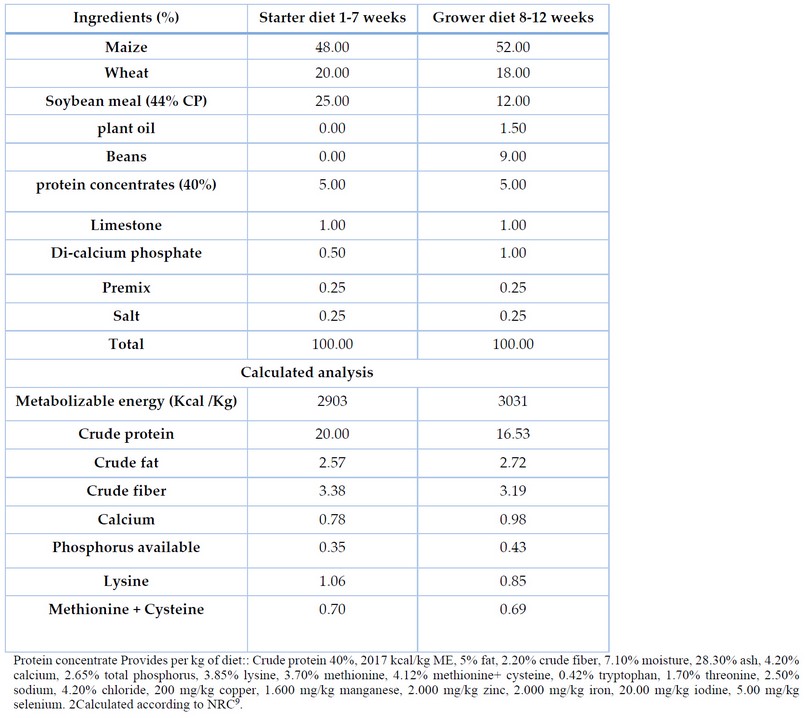
Table 1. Ingredients and nutrient composition of goose starter and grower diets.
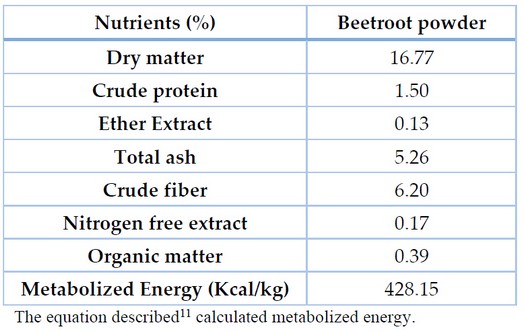
Table 2. The beetroot powder's chemical composition (% on a dry weight basis).
Beetroot samples were brought from the local market, washed, dried, and ground, 20 g of powder was taken and placed in 250 ml distilled water to prepare the aqueous extract, placed in a vibrator for one hour, the extract was filtered by filter paper (Whatman No 1) and a water bath concentrated the filtrate at 50 °C until full drying12.
RESULTS
Table 3 shows the effect of beetroot (Beta vulgaris rubra) powder and its aqueous extract to the ration and drinking water on carcass weight and dressing ratio with or without giblet of goose carcasses (mean ± standard error), there was a significant effect of beetroot on carcass weight, as treatments T4 and T2 were significantly (P≤0.05) outperformed compared to treatment T3, which was significantly (P≤0.05) superior to treatment T5, which was significantly superior to the control treatment, the average carcass weight was 1690.41, 2103.41, 1933.43, 2079.53 and 1853.55 g for treatments T1, T2, T3, T4 and T5, respectively.
As for the dressing ratio with and without giblet, it was also noticed that T2 and T4 were significantly superior to the treatment of T5, in turn significantly superior at the expense of the control treatment. There are no significant differences between the treatments T2, T3 and T4 and the treatments T3 and T4.The dressing percentage without giblet was 64.51, 67.97, 66.88, 67.81 and 66.20%, the dressing percentage with giblet was 69.48, 73.56, 72.13, 73.37 and 71.40% for treatments T1, T2, T3, T4 and T5, respectively.
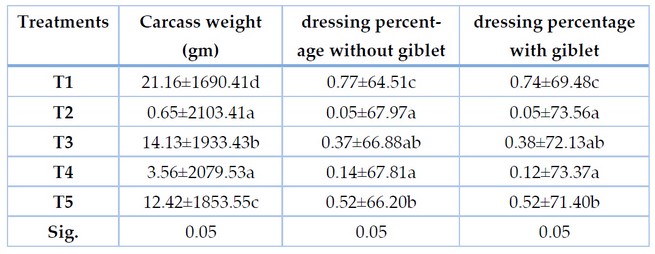
Table 3. Effect of beetroot (Beta vulgaris rubra) powder and its aqueous extract to diet and drinking water on carcass weight, dressing percentage with and without giblet of goose carcasses (mean ± standard error).
Table 4 shows the effect of beetroot (Beta vulgaris rubra) powder and its aqueous extract to the ration and drinking water on the relative weight of giblet and belly fat of goose carcasses; there was no significant effect of all experimental treatments on the relative weight of the heart. The mean relative weight of the heart was 0.64, 0.68, 0.66, 0.67 and 0.65% for the T1, T2, T3, T4 and T5 treatments, respectively.
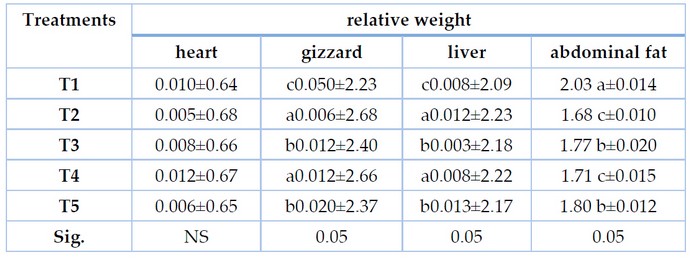
Table 4. Effect of beetroot (Beta vulgaris rubra) powder and its aqueous extract to diet and drinking water on the relative weight of giblet and belly fat of goose carcasses (mean ± standard error).
As for the relative weight of gizzard and liver (Table 4), there was a significant effect of beetroot treatments, the relative weight of gizzard and liver increased significantly (P≤0.05) in treatments T2 and T4 compared to treatments T3 and T5, which showed a significant difference (P≤0.05) compared to the control treatment, there were no significant differences between treatments T2 and T4 and treatments T3 and T5, the relative weight of the gizzard was 2.23, 2.68, 2.40, 2.66 and 2.37%, the relative weight of the liver was 2.09, 2.23, 2.18, 2.22 and 2.17% for the T1, T2, T3, T4 and T5 treatments, respectively.
As for relative weight of abdominal fat, a significant decrease (P≤0.05) was observed in treatments T2 and T4 compared to treatments T3 and T5, which showed a significant decrease (P≤0.05) compared to the control treatment, there were no significant differences between treatments T2 and T4 and treatments T3 and T5. The relative weight of abdominal fat was 2.03, 1.68, 1.77, 1.71 and 1.80% for the treatments T1, T2, T3, T4 and T5, respectively.
Table (5) shows the effect of beetroot powder (Beta vulgaris rubra) and its aqueous extract to diet and drinking water on the relative weight of the breast and thigh of goose carcasses, there was a significant effect (P≤0.05) of beetroot treatments on the relative weight of the breast and thigh, there was a significant increase (P≤0.05) on the relative weight of the breast in treatments T2 and T4 compared to treatments T3 and T5, which showed a significant (P≤0.05) superiority compared to the control treatment. There were no significant differences between treatments T2 and T4 and treatments T3 and T5. The mean RWR was 25.88, 27.47, 26.58, 27.24 and 26.40% for the T1, T2, T3, T4 and T5 treatments, respectively.
As for the relative weight of the thigh, there was a significant increase (P≤0.05) in treatments T2 and T4 compared to treatment T3, a significantly superior (P≤0.05) compared to T5, which was significantly (P≤0.05) superior to the control treatment, the mean relative weight of the thigh was 19.96, 20.85, 20.46, 20.76 and 20.28% for the T1, T2, T3, T4 and T5 treatments, respectively.
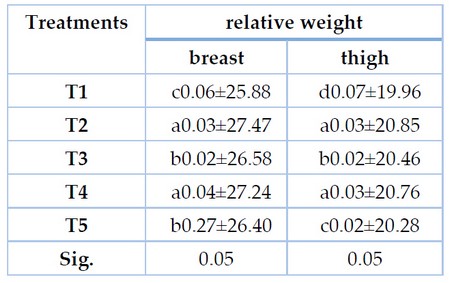
Table 5. Effect of beetroot (Beta vulgaris rubra) powder and its aqueous extract to diet and drinking water on the relative weight of breast and thigh of goose carcasses (mean ± standard error).
Table 6 indicates the effect of beetroot (Beta vulgaris rubra) powder and its aqueous extract to diet and drinking water on carcass length, keel bone length, thigh circumference and body fullness of goose carcasses (mean ± standard error). It was noticed that there was a significant increase (P≤0.05) in carcass length for treatment T2 compared to treatment T5 that was significantly superior (P≤0.05) compare with control treatment. There were no significant differences between the treatments T2, T3 and T4 and the treatments T3, T4 and T5. Average carcass length was 28.67, 32.67, 31.00, 32.00 and 30.33 cm for T1, T2, T3, T4 and T5 treatments, respectively.
As for keel bone length, it was noted that there is a significant increase (P≤0.05) for treatments T2 and T4 compared to treatments T3 and T5, which showed a significant increase (P≤0.05) compared to the control treatment, there were no significant differences between treatments T2 and T4 and treatments T3 and T5. The mean keel bone length was 10.33, 11.96, 10.93, 11.80 and 10.83 cm for parameters T1, T2, T3, T4 and T5, respectively.
The results indicate a significant increase (P≤0.05) in thigh circumference for treatments T2 and T4 compared to treatments T1, T3 and T5. There were no significant differences between treatments T2 and T4 and between treatments T1, T3 and T5. The mean thigh circumference was 18.67, 22.90, 20.33, 22.67 and 20.00 cm for T1, T2, T3, T4 and T5 parameters, respectively.
As for the degree of body fullness, a significant increase (P≤0.05) was observed in the T4 treatment compared to the control treatment, there were no significant differences between T2, T3 and T4 and T2, T3 and T5 and T1, T3 and T5 treatments. Body fullness was 58.97, 64.40, 62.41, 65.02 and 61.14 cm for T1, T2, T3, T4 and T5 parameters, respectively.
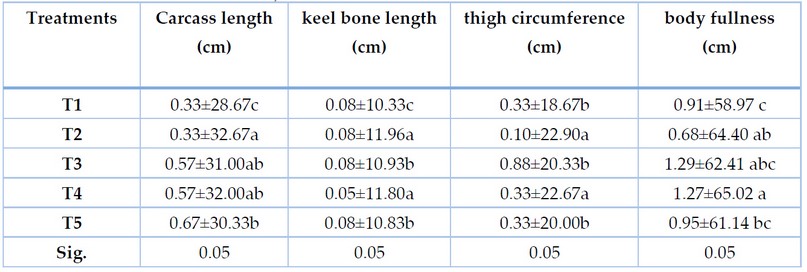
Table 6. Effect of beetroot (Beta vulgaris rubra) powder and its aqueous extract to diet and drinking water on carcass length, keel bone length, thigh circumference and body fullness of goose carcasses (mean ± standard error).
Table 7 shows the effect of beetroot (Beta vulgaris rubra) powder and its aqueous extract on diet and drinking water on goose carcasses' length, circumference and breast fullness (mean ± standard error). There was a significant (P≤0.05) increase in breast length in treatments T2 and T4 compared to treatments T3 and T5, which showed a significant increase (P≤0.05) compared to the control treatment. There were no significant differences between treatments T2 and T4 and treatments T3 and T5. Average breast length was 18.83, 22.50, 21.16, 22.33 and 20.33 cm for parameters T1, T2, T3, T4 and T5, respectively.
As for the breast circumference, it was noted that all beetroot treatments were significantly (P≤0.05) superior to the control treatment. The mean breast circumference was 29.33, 32.67, 31.67, 32.33 and 31.33 cm for T1, T2, T3, T4 and T5 parameters, respectively.
There are no significant differences between all the treatments in the degree of breast fullness, the average was 1.021, 1.000, 1.022, 1.011 and 1.033 cm for coefficients T1, T2, T3, T4 and T5, respectively.
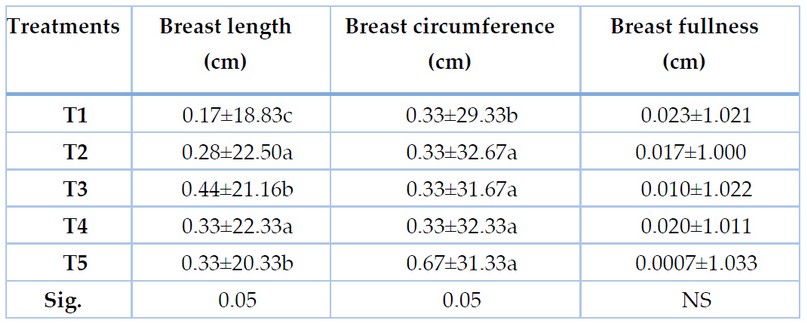
Table 7. Effect of beetroot (Beta vulgaris rubra) powder and its aqueous extract to diet and drinking water on carcass length, keel bone length, thigh circumference and body fullness of goose carcasses (mean ± standard error).
DISCUSSION
The use of beetroot, whether as an aqueous extract in drinking water or as a powder in fodder, significantly improved the characteristics of the studied carcass.
This improvement may be due to the improvement in the average weight of the carcass, which leads to an improvement in the characteristics of the carcass, or it may be because beetroot contains effective compounds, the most important of which is betalain, which has an important role as an antioxidant 13 Moreover, beetroot also improves the health of the digestive system, improves lipid metabolism, and has antioxidant and lipid peroxidation inhibitory effects 14,15,16
CONCLUSIONS
Results indicate that the use of beetroot significantly improved all traits of the studied goose carcass compared to the control treatment, the addition of the aqueous extract at a concentration of 15 ml/ liter of drinking water and beetroot powder at a concentration of 15 g to the feed gave the best results and significantly compared to the rest of the treatments.
REFERENCES
1. Ninfali, P. and D. Angelino. Nutritional and functional potential of Beta vulgaris cicla and rubra. Fitoterapia. 2013. 89:188-199.
2. Vuli´c, J.J.; T.N. Cebovi´c; J.M.´Canadanovi´c-Brunet; G.S. Cetkovi´c; V.M. Canadanovi´c; S.M. Djilas and V.T.T. Šaponjac. In vivo and in vitro antioxidant effects of beetroot pomace extracts. J. Funct. Foods. 2014. 6: 168-175.
3. Pietrzkowski, Z.; B. Nemzer; A. Spórna; P. Stalica; W. Tresher; R. R. Keller Jiminez; T. Michalowski and S. Wybraniec. Influence of betalin-rich extracts on reduction of discomfort associated with osteoarthritis. New. Med. 2010, 1:12-17.
4. Abdulateef SM, Al-Bayar MA, Majid AA, Shawkat SS, Tatar A, Al-Ani MQ. Effect of exposure to different light colors on embryonic development and neurophysiological traits in the chick embryo. Veterinary World. 2021 May;14(5):1284.
5. Kapadia, G.J.; M.A. Azuine; G.S. Rao; T. Arai; A. Iida and H. Tokuda. Cytotoxic effect of the red beetroot (Beta vulgaris L.) extract compared to doxorubicin (Adriamycin) in the human prostate (PC-3) and breast (MCF-7) cancer cell lines. Anti -Cancer Agent Med. Chem. 2011. 11:280-284.
6. Al-Muzani, Z.Z. and M.H. Al-Asadi. Study the predictive relationship of Chinese geese breeding growth in local conditions in Iraq. PAJEE. 2021, 18(17):1650-1658.
7. AL- Shamary, W. A. .; Alkhateb, B. A. A. H. .; Abdel, E. T. . Role Of Perlite Quantity And Intervals Of Irrigation On Potatoes (Solanum Tuberosum L.) Grown In Gypsiferous Soil. Journal of Life Science and Applied Research. 2020, 1, 31-39
8. Selim, N.A.; S.F. Youssef; A.F. Abdel-Salam and Sh. A. Nada. Evaluation of Some Natural Antioxidant Sources in Broiler Diets: 1-Effect on Growth, Physiological, Microbiological and Immunological Performance of Broiler Chicks. International Journal of Poultry Science, 2013. 12 (10): 561-571.
9. Grace, T.O., A. Olajide, O.M. Dupe, T. Boluwatife and M.O. Akinyemi. Effect of Beetroot Juice (Beta vulgaris) on Growth Performance, Blood Profile and Carcass Characteristics of Broiler Chicken. International Journal of Poultry Science, 2020.19: 303-308.
10. NRC. National Resource Council. Nutrient Requirements of Poultry. 9th rev. ed.: Washington: National Academy Press. 1994.
11. AOAC. Official Methods of Analysis, 19th ed.:.Association of official Analytical Chemist, Washington DC. 2012.
12. Alkubaisy,S.A., A.A. Majid, S.M. Abdulateef, F.A. Al-Bazy, O.K. Attallah, O.M. Abdualmajeed, Th. T. Mohammed, F.M. Abdulateef, K.I. Mahmud. Effects of In-Ovo injection of Biotin on chick's embryonic development and physiological traits. IOP Conference Series: Earth and Environmental Science.2021, 761(1), 012111.
13. Nahla, TK Antioxidant Activities of Beetroot (Beta vulgaris L.) Extracts. Pakistan Journal of Nutrition 2018. 17(10):500-505.
14. Ahmad, A. Sh., F.T. Al-Rawi, Y.T. Abdul-Rahaman, TH. T. Mohammed, K.I. Mahmud. Effect of Tryptophan injection on the semen quality in Iraqi Shami buck. IOP Conference Series: Earth and Environmental Science, 2021, 761(1), 012093.
15. Yehya, W. A. . Seasonal Monumental Insects Accompanying Euphrates Poplar Leaves. Journal of Life Science and Applied Research.2020, 1, 45-53..
16. Jassim, J.M., R. Mossa, M.H. Al-Assadi and Y. Gong. Evaluation of Physical and Chemical Characteristics of Male and Female Ducks Carcasses at Different Ages. Pakistan Journal of Nutrition, 2011. 10:182-189.
Received: January 15, 2023 / Accepted: February 25, 2023 / Published:15 March 2023
Citation: Al-waeli, S.K.J.; Alasadi, M.H.A.; Abbas R.J. Effect of supplementing beetroot (Beta vulgaris rubra) powder and its aqueous extract on carcass quality and carcass measurements of growing goose. Revis Bionatura 2023;8 (1) 79. http://dx.doi.org/10.21931/RB/2023.08.01.79
